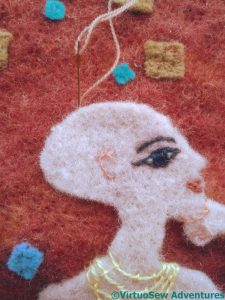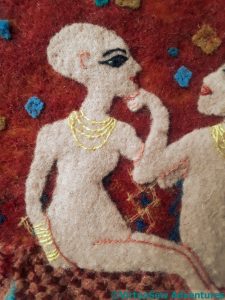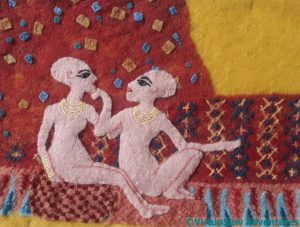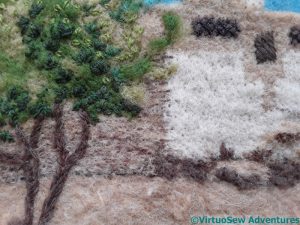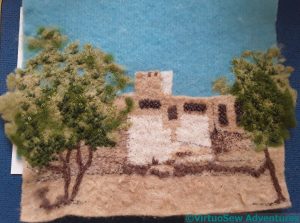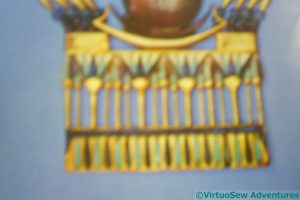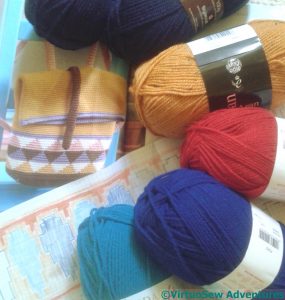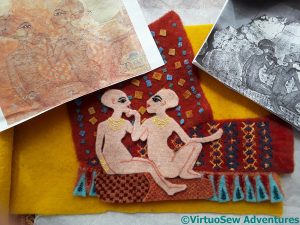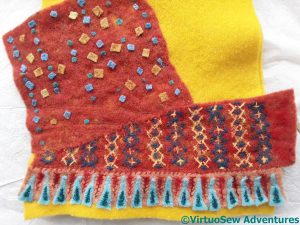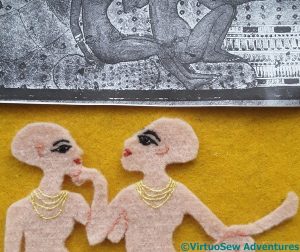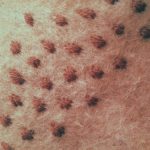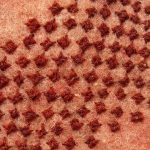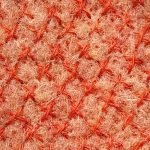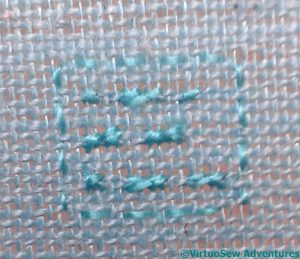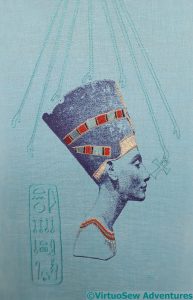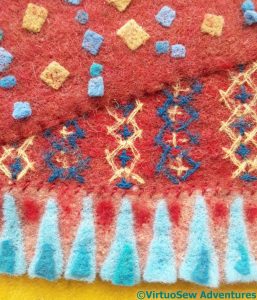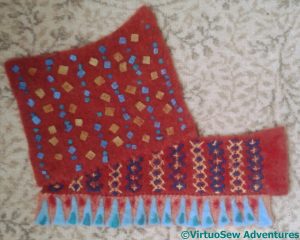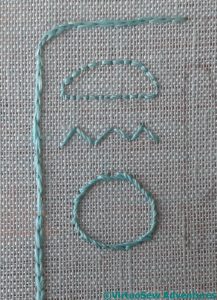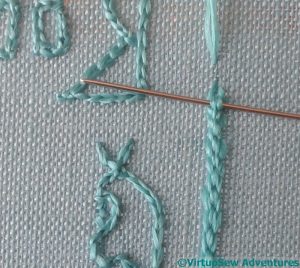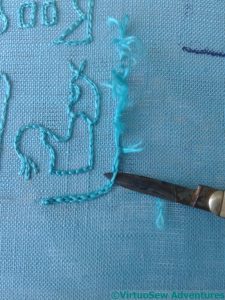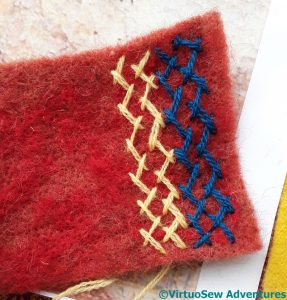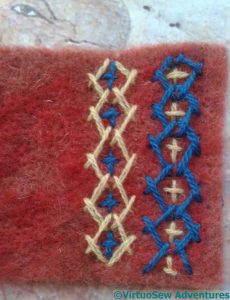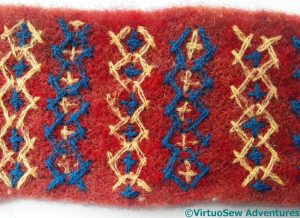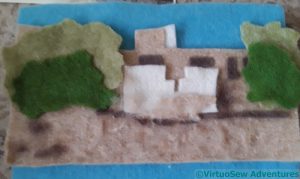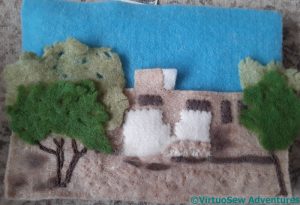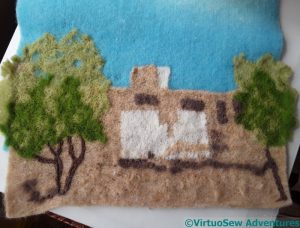Category: Dreams of Amarna
Two Amarna Princesses – Finishing Details
I decided that I would actually sew down the princesses. Everything else has been needlefelted into place, but the texture that creates, especially on a light felt, is a bit too regimented for the impression I want to convey.
I’ve very carefully, and as near as I can make it, invisibly, attached the felt around the edges, stitching into the thickness of the felt that makes the two girls and using a wool thread that is close in colour to the felt.
So far, so good.
I then used a hand needlefelting tool and went just around the edges, and into the sections that are further back. I’m trying to create a slightly sculptural effect, so that the princesses have a slight roundness to them. Remember how, at the beginning, I said I wanted to recall the scene as the original fresco artist may have seen it, as well as recalling the fresco itself?
I’m rather pleased with my two little princesses.
I need to work a little magic in straightening up the panel and working out how to display it, as I think the three felt panels that I’ve done so far would all die if put behind glass, and may not even be happy in frames. A question for another day.
Dig House Progress
I’ve not finished the Dig House panel yet, but I’m working on it!
I’ve tried to add detail and shading to the walls of the house by running threads underneath the top layer of felt, and then running the embellisher over the top to help that added layer to show through a little more.
I’m also adding a lot of detached chain stitch leaves to the trees. This is overbalancing the detail on the whole piece, pulling the eye out to the side, so although I still need to do more of this, I need to sharpen up the details on the central section a bit more as well.
It’s easy to make this sort of mistake when you’re making something up as you go along – they don’t always arrive in your head fully formed! – but fortunately, a bit of my favourite thoughtful staring helped me to work out what I need to do.
Now it is just a matter of actually doing it right….
Amarna Backpack
Those of you who follow me on Instagram or Twitter will have noticed that the embroidery you mostly see has been supplemented by the occasional piece of crochet over the past few months. I’ve found my crochet projects easier to travel with than embroidery, and it’s a different sort of puzzle to solve.
I’ve done a few shawls or scarves, and a pair of socks, and while I try to work out whether crocheted lacy socks are really “me”, I thought I would try something else that isn’t flat. Issue fifty five of Simply Crochet contained a backpack project designed by Ilaria Caliri. The colours didn’t really appeal to me, but the idea of the structure, and the tapestry crochet band across the middle, definitely did.
I started playing around with ideas for colours and designs, and it took me really quite some time to settle on something simple and repetitive enough that it might actually work. The dreadful picture of a picture at the beginning of this post is one of the pictures I took when the EES let me spend a day in their library, and I think that the fact it was so poor really helped me to cut out frills.
The backpack will be navy blue, and the tapestry crochet band is a series of petal shapes in turquoise and lapis, with a background of gold, and bordered with carnelian (approximately!). I had a lovely half hour in SMD Knitting while we found the right shades of acrylic aran-weight yarn, and now all I have to do (all!) is decide whether my petals will be broad end up or broad end down and then get to work…
Two Amarna Princesses – the results of thought
The felted cushion fragments worked rather well, surviving the cutting out procedure so that I could start to play with the layout. Prints of the images I’d used to hand, I fiddled happily for quite a while.
This isn’t quite what I ended up with, but you can see how vividly the colours play off against one another. Very promising!
The first stage was to attach the drapery assembly to the background. This is where the experimental nature of my needlefelting may come back to bite me, because there is a risk that I have taken it too far, and that I will finish with a completely destroyed background.
However, the goldeny-mustardy-yellow wall shows through a bit, which is what I want, as that helps to make the connection with the frescoes at Amarna as they are found by archaeologists – fragile and fragmentary, only a hint of their former glory. I may have to hand-needlefelt some of those little squares, as they’re not as well attached as I would like. I don’t want them falling off at some time in the future!
Two Amarna Princesses – having to think again
A little while ago, the Ashmolean Museum tweeted another reproduction of that fresco of the two little princesses, this one in black and white, and it brought to the fore something that had been less clear in the colour reproductions I had seen – the girls are actually sitting on cushions. Originally, I had interpreted the lowest border design as fabric covering a divan of some sort, but now I found myself developing some possible cushion fabrics..
- Satin Stitch Spots
- Sorbello Stitch Spots
- Cross Stitch Spots
Once again, as with the drapery, I stitched patterns with additional needlefelting in mind. I decided in the end that the satin stitch spots weren’t working very well. Sorbello stitch is the stitch I used for the villages on the Map of Amarna. It’s another stitch I rather like, as it produces a neat, square stitch, with an interesting texture – more obvious with some fabrics and threads than others, of course. The cross stitch spots are in a colour closer to that of the felt, and should produce a more subtle effect.
What I have done is to stitch the patterns on a section of felt, and then pass it under my embellisher. I hope that this will create enough fibre entanglement that when I cut out the cushion shapes, the stitches will not unstitch themselves.
I wonder whether it will work…!
Finishing the Head of Nefertiti
Unless I decide otherwise, the head of Nefertiti is now finished.
I’ve worked my Morse Code cartouche slightly differently this time, using cross stitch for the dots, long armed cross stitch for the dashes, and counted running stitch for the frame. This works rather well, so it’s a possibility for any eventual canvaswork projects in the future.
However, in this instance it is almost completely invisible, so I may yet unpick it and rework it twice the size, with four threads in each direction instead of two.
In the end, if you recall, I decided to work Nefertiti’s cartouche, both the hieroglyphs and the frame, in reverse chain stitch using untwisted silk.
The rays of the Aten are worked in reverse chain stitch, but using hand twisted silk.
I am a little concerned about balance and the strength of the design, but when I was playing with my photos of of the finished panel, I noticed that when I cropped the picture closely, rather than including all of the length I have stitched of the rays of the Aten, it was much improved.
That happened with the Camberwell Panel, and with Loading the Felucca, as well, so I shouldn’t be surprised.
And I really should remember to play with that sort of detail when I am mounting and finishing my embroideries!
Two Amarna Princesses – Assembling the Drapery
Having chosen my bits of drapery, I’ve stitched them together at the edges.
This means that they won’t move when I’m felting them to the background, and that I could actually cut off some of the second drapery, rather than overlapping it on the first. This will reduce the number of layers I will be felting through, which turns out to be a good idea. I don’t want any more broken needles, thank you very much!
The assembled drapery now makes a rather peculiar shape, but it gives me part of the background for my princesses, and a basis for any further embellishment I may feel is necessary.
However, as I was contemplating that eventual embellishment, I found another source picture and now I have to do a little more thinking.
The Cartouche for the Head of Nefertiti
There were many false starts when I came to work on the cartouche. The fabric is under such tension, in order to work the metal and silk stitches, that it’s hard not to create something that looks very fragile and wispy.
Here you see stem stitches, back stitches, straight stitches, chain stitches of different lengths, some worked using the same twisted thread I used for the rays of the Aten, and some in untwisted thread of the same thickness.
And I didn’t like any of them.
In fact, I ended up doubling the thickness of the thread, but not actually twisting it. This creates a more definite line, and using reverse chain stitch throughout maintains the sense of continuity with the rays of the Aten.
Once I had finished the hieroglyphs, I had to work the frame of the cartouche, and guess what – false starts here as well.
I was rather saddened that among the stitches tried was one of my favourites, Hungarian Braided Chain Stitch, and that, like several others, ended up being sliced out with a penknife. A rather nice penknife with a mother of pearl handle, from a vintage sewing set, but it’s frustrating to dismiss a favourite stitch, even when it’s because you don’t think it works in the context.
After much to-ing and fro-ing, and a good few “ouches” from my recalcitrant sub-scapularis muscle, I finally got the cartouche finished.
I’m not entirely sure I like the finished result, so it is sitting in the living room, being stared at.
The Two Amarna Princesses – Drapery, stage 3
For my next drapery experiment, I began by using the embellisher to add some of that divided felt onto another piece – do you see that the red is in patches, a dark pink (the background) and a rather brighter scarlet? That worked well, I think, as it has warmed up the colour, and made it more interesting.
I had decided that I would stitch a pattern and then use the embellisher to make it blend in a little more, but once I’d worked this pattern of herringbone stitch stripes, I sat back, stared at it, and said “No”.
So the second pattern I tried was a little more complex. It’s still worked largely in herringbone stitch, and the colours are the same, but this time I’ve reversed the second row to create a series of lozenge shapes, which could then be filled in, after a fashion, with little upright cross stitches.
I liked this much more, so I decided to go with this pattern.
Although, of course, I was referring to the picture that was my original spacing, that red is very reminiscent of Persian carpets, and the combination with blue and yellow is one which we still find in widespread use.
The next stage was to use the embellisher again. To begin with, I covered the stitching with a layer of net, and worked an initial pass of small circling movements, up and down each stripe. Then I removed the net and kept going.
As you can see, the stitching is almost melting into the background. Certainly it’s a more convincing representation of a piece of fabric than my first piece of drapery, although I will be using both.
Another Attempt at the Dig House
I’m continuing to experiment with my embellisher, trying to learn new tricks.
I’ve found a photo of the Dig House from a different view to the previous one I tried, and cut out some pieces of felt to represent the trees and the various pieces of building. It’s not going to be a very accurate representation, because, firstly, my cutting wasn’t as accurate as it could have been, and second, I’ve found that needlefelting doesn’t always go to plan.
That said, a bit of stitchery helps to keep the pieces at least approximately in place.
I felt the felt of the trees looked a bit too solid, and snipped holes in it, snipped the edges, and then tugged and tweaked at it to open up the fabric.
Then I started to use my embellisher. And oh joy, a needle broke! I changed the needle plate and slowed down a bit after that. It turns out that three layers of even this fairly light felt are a bit much for the machine.
However, after much slow and careful embellishing, I have this.
The trees look much better now, with the edges and the holes satisfactorily destroyed and battered around the edges. The various layers of felt are melting into one another and flattening together.
This should at least provide me with an interesting basis for further stitched details!

